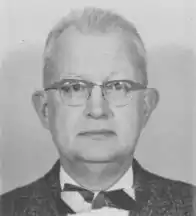Philip Sartwell
Dr. Philip E. Sartwell (1908–1999) was a noted epidemiologist and professor at the Johns Hopkins School of Hygiene and Public Health.
Philip E. Sartwell | |
|---|---|
 | |
| Born | 1908 Salem, MA, USA |
| Died | Nov 26, 1999 Marblehead, MA, USA |
| Nationality | American |
Education
Dr. Sartwell obtained a medical degree in 1932 from the Boston University School of Medicine, and in 1938 earned a master's in public health degree from the Harvard University School of Public Health.[1]
Career
After his formal education, Dr. Sartwell was the Assistant Director of the Division of Tuberculosis in the Massachusetts Department of Health for five years.[2] In 1943, during World War II, he joined the U.S. Army serving as a major in the Epidemiology Section in the Office of the Surgeon General.
Dr. Sartwell joined the faculty at the Johns Hopkins University School of Hygiene and Public Health's Department of Epidemiology in 1947. He served as Chair of the Department of Epidemiology from 1954-1970.[1][3] He served as the Editor-in-Chief of the American Journal of Epidemiology from 1957-58.
Dr. Sartwell additionally established the journal Epidemiologic Reviews and served as its first editor-in-chief from 1979-1982.[4] Dr. Sartwell was additionally involved in the US Centers for Disease Control and Prevention's (CDC's) Epidemic Intelligence Service (EIS) on the team that trained the first class of EIS officers in the year 1951.[5] He was the first president of the Maryland Public Health Association when it was founded in 1955.
Research interests
Dr. Sartwell's epidemiologic research covered a wide range of fields. His work on the incubation periods of infectious diseases is highly regarded to this day and considered a foundation of modern infectious disease epidemiology.[6][7] He is remembered for his work on the association between oral contraceptives and thromboembolism[8] as well as breast cancer.[9] He additionally assessed the harm of occupational exposure to radiation.[10] His work included assessing the effectiveness of vaccination against influenza and polio.[1] He is known for Sartwell's law.[11]
References
- "Philip E. Sartwell, 91, noted Hopkins epidemiologist". tribunedigital-baltimoresun. Retrieved 2015-10-25.
- The Editors (2000-03-01). "In Memoriam: Philip E. Sartwell (1908–1999)". American Journal of Epidemiology. 151 (5): 439. doi:10.1093/oxfordjournals.aje.a010227. ISSN 0002-9262.
- "History of the Department". Johns Hopkins Bloomberg School of Public Health. Retrieved 2015-10-25.
- Sartwell, Philip E.; Stark, Frances (1991-11-15). "American Journal of Epidemiology:Its Evolution since 1965". American Journal of Epidemiology. 134 (10): 1041–1046. doi:10.1093/oxfordjournals.aje.a116004. ISSN 0002-9262. PMID 1746511.
- "Sentinel for Health". University of California Press. Retrieved 2015-10-25.
- Sartwell, PE. "THE DISTRIBUTION OF INCUBATION PERIODS OF INFECTIOUS DISEASE" (PDF).
- Coulter, Jane E. (1951-01-01). "Review". The Milbank Memorial Fund Quarterly. 29 (1): 123–125. doi:10.2307/3348513. JSTOR 3348513.
- Sartwell, Philip E.; Masi, Alfonse T.; Arthes, Federico G.; Greene, Gerald R.; Smith, Helen E. (1969-11-01). "Thromboembolism and Oral Contraceptivers: An Epidemiologic Case-Control Study". American Journal of Epidemiology. 90 (5): 365–380. doi:10.1093/oxfordjournals.aje.a121082. ISSN 0002-9262. PMID 5395236.
- Sartwell, Philip E.; Arthes, Federico G.; Tonascia, James A. (1973). "Epidemiology of Benign Breast Lesions: Lack of Association with Oral Contraceptive Use". New England Journal of Medicine. 288 (11): 551–554. doi:10.1056/nejm197303152881104. PMID 4685452.
- Seltser, Raymond; Sartwell, Philip E. (1965-01-01). "The Influence of Occupational Exposure to Radiation on the Mortality of American Radiologists and Other Medical Specialists". American Journal of Epidemiology. 81 (1): 2–22. doi:10.1093/oxfordjournals.aje.a120493. ISSN 0002-9262. PMID 14246078.
- url = https://phys.org/news/2018-01-randomness-key-disease-evil.html
